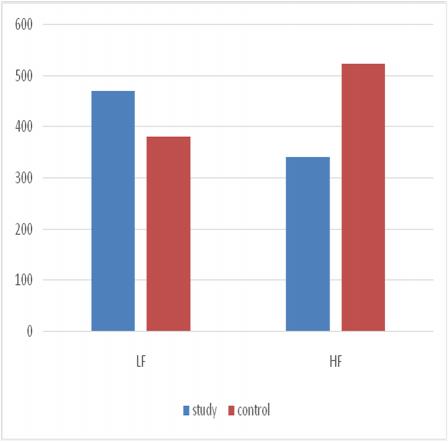
A Study of Heart Rate Variability among Young Adults with History of Parental Hypertension
Abstract
INTRODUCTION: Essential Hypertension is
characterised by an increase in sympathetic nervous system
activity and reduced vagal modulations. Several studies
utilizing invasive techniques such as Muscle Sympathetic
Nervous Activity (MSNA) recordings and measurements of
norepinephrine spillover have shown augumented
sympathetic activity in normotensive subjects with a family
history of Hypertension. This study is an effort to use
noninvasive technique like Heart Rate Variability (HRV) to
examine autonomic control in normotensive subjects with
family history of hypertension. If autonomic differences
can be detected before any elevation in blood pressure, then
design of the scheme for the noninvasive early detection
of hypertension and primary prevention can be done.
AIM AND OBJECTIVES: To study the heart rate variability
among young adults with history of parental hypertension.
STUDY DESIGN: Observational case control study.
SAMPLE SIZE: 60. MATERIAL AND METHODOLOGY:
After obtaining Ethical committee approval, Medical and
Paramedical students were selected. Students were asked
to assemble in Physiology laboratory between 9 AM and
10 AM after 2 hours of light breakfast without caffeinated
drinks. ECG electrodes were connected for lead II. Baseline
heart rate and blood pressure were recorded. Then at
supine rest with the eyes closed and relaxed position, lead II
ECG was acquired at the rate of 200 samples/second for
10 minutes with the normal breath rate of 12-18/min using
RMS Polyrite D Hardware India, which is the data acquisition
system. HRV analysis (frequency domain parameters LF,
HF, LF/HF) were noted and statistically analyzed using
unpaired student ‘ t’ test and p value of < 0.05 was taken
significant. RESULT: Study group shows a high statistical
significance (p < 0.001) values in HRV indices like lower
HF, high LF and high LF / HF ratio when compared to that
of control group though Mean value of Arterial Blood
Pressure remained insignificant among study and control
group. CONCLUSION: This study concludes that Persons with
parental history of hypertension had more sympathetic drive
besides normal blood pressure. Hence family history of
hypertension is a risk factor for developing hypertension.
Heart rate variability analysis can be used as an effective and
noninvasive method in identifying high risk persons. Primary
prevention methods should be advised to delay the incidence
of Hypertension among the high risk group.
Full Text:
PDFReferences
Akselrod S, Gordon D, Ubel FA, Shannon DC, Berger AC
and Cohen RJ. Power spectrum analysis of heart rate
fluctuation:a quantitative probe of beat-to-beat cardiovascular
control. Science 213: 220–222, 1981.
Akselrod S, Oz O, Greenberg M, and Keselbrener L.
Autonomic response to change of posture among normal and
mild hypertensive adults: investigation by time-dependent
spectral analysis. J Auton Nerv Syst 64: 33–43, 1997.
Anonymous. Physical activity, physical fitness, and
hypertension. Med Sci SportsExerc25: R1–R10, 1993.
Aono T, Sato T, Nishinaga M, Kawamoto A, and Ozawa T.
Power spectral analysis of spontaneous blood pressure and
heart rate variability in elderly hypertensives. Hypertens Res
: 9–16, 1996.
August P. Initial treatment of hypertension. N Engl J Med
: 610–617, 2003
Berger RD, Akselrod S, Gordon D, and Cohen RJ. An
efficient algorithm for spectral analysis of heart rate
variability. IEEE Trans Biomed Eng33: 900–904, 1986.
Camm AJ, Malik M, Bigger J, Breithardt G,
Cerutti S, Cohen R, Coumel P, Fallen E, Kennedy H,
KleigerR,Lombardi F, Malliani A, Moss A, Rottman J,
Schmidt G, Schwartz P, and Singer D. Heart rate variability:
standards of measurement, physiological interpretation, and
clinical use. Circulation93: 1043–1065, 1996.
European Society of Hypertension. Consensus meeting
on baroreflex sensitivity indices derived from spontaneous
fluctuations of blood pressure and heart rate. J Hypertens. In
press.
Fagius J and Karhuvaara S. Sympathetic activity and
blood pressure increases with bladder distension in humans.
Hypertension14: 511–517, 1989.
Ferrier C, Cox H, and Esler M. Elevated total body
noradrenaline spillover in normotensive members of
hypertensive families. ClinSci (Lond) 84: 225–230, 1993
Refbacks
- There are currently no refbacks.

This work is licensed under a Creative Commons Attribution-NoDerivatives 4.0 International License.
An initiative of The Tamil Nadu Dr M.G.R. Medical University